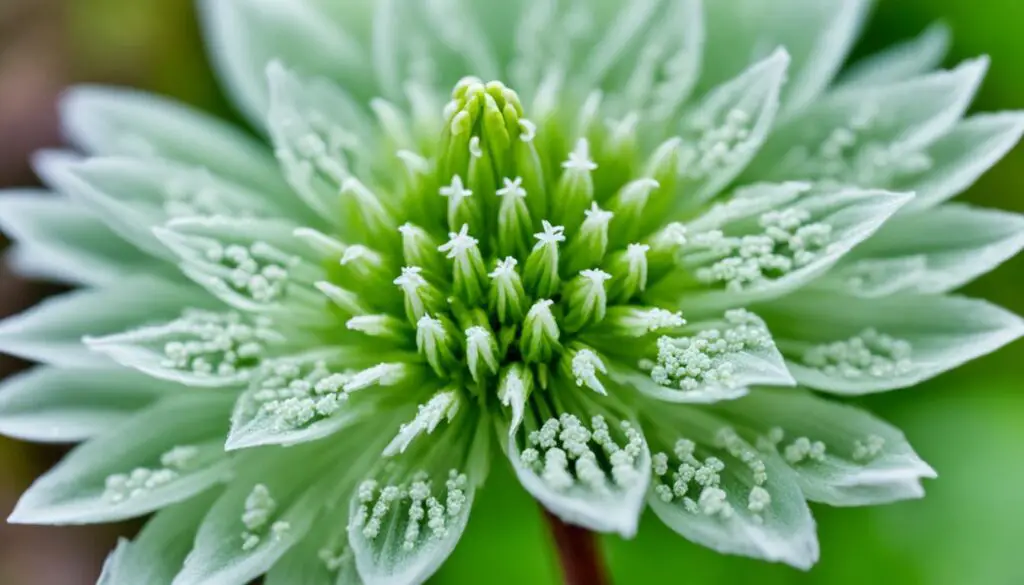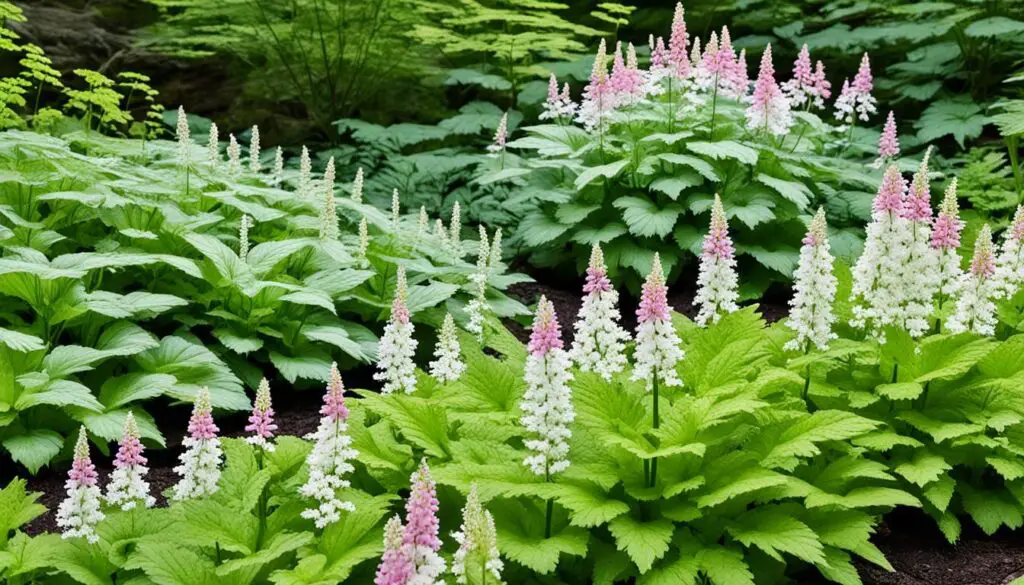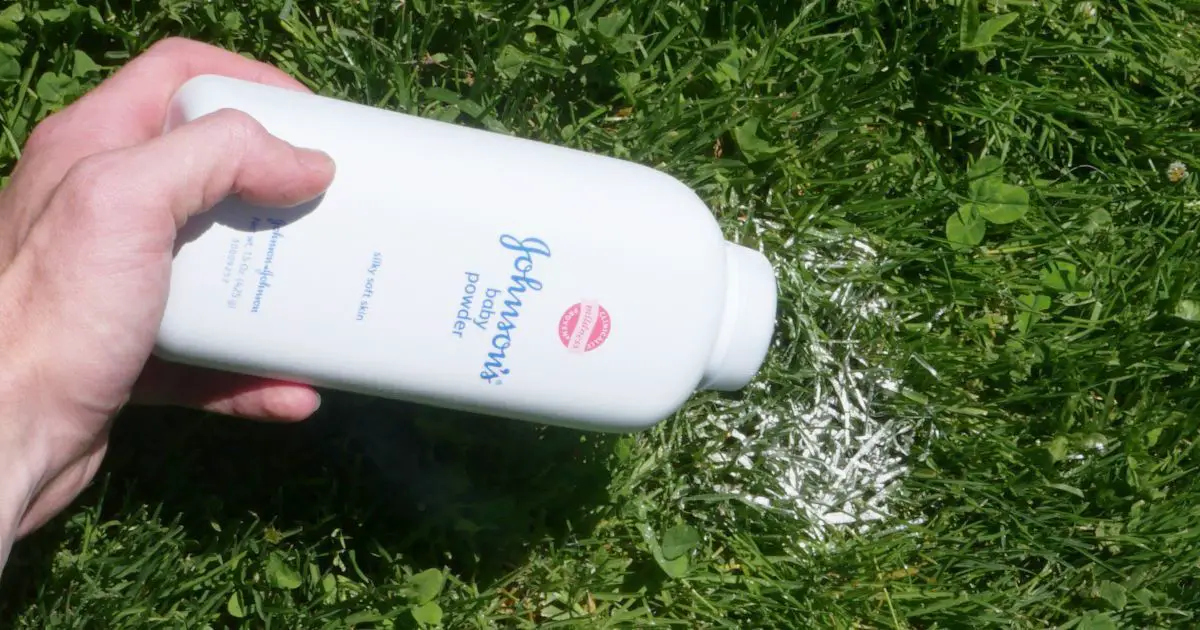Foamflower is a native perennial wildflower known for its foamy white to pinkish flowers. These flowers appear on long stems from a dense foliage mound in spring. It thrives in woodland conditions, preferring shade and rich soil. The plant can handle acidic soil and grows under trees.
This cold-hardy flower likes moderate summer temperatures. It does best in part to full shade and rich soil that stays moist but not wet.
Foamflower looks great in masses along borders with other shade-loving plants. It’s perfect for woodland, ornamental, and wildflower gardens.
Foamflower is easy to grow, with many species native to the United States. While it can grow in full shade, it prefers a bit of sun. This encourages vibrant foliage and lots of blooms.

Key Takeaways
- Foamflower (Tiarella cordifolia) is a cold-hardy, shade-loving perennial native to North America.
- Foamflower prefers partial to full shade and moist, well-draining, humus-rich soil with a pH of 6.2-6.5.
- Foamflower blooms in spring with white to pink flowers and grows 6-12 inches tall and 12-24 inches wide.
- Foamflower is easy to cultivate and propagate, with division being the most common method.
- Foamflower is a great pollinator plant and works well in woodland, ornamental, and wildflower gardens.
What is Foamflower?
Botanical Details
Foamflower is also known as Allegheny foamflower, false miterwort, heartleaf foamflower, foam flower, and threeleaf foamflower. Its botanical name is Tiarella cordifolia. It’s part of the Saxifragaceae family. This perennial plant grows 1-3 feet tall and 6-12 inches wide.
The leaves are heart-shaped and often have red or burgundy patterns. In spring, it produces spires of white or pink flowers.
These flowers have a light scent to draw in pollinators. They last about 4 to 6 weeks.
After the flowers fade, the dark green leaves keep the area looking good. They set the stage for other plants to shine.
| Foamflower Characteristics | Details |
|---|---|
| Bloom Time | Foamflowers bloom for about a month to a month and a half. |
| Seed Germination | Germination of foamflower seeds can take a couple of weeks to three months, depending on geographical regions and seed viability. |
| Growth from Seed | Foamflower plants are slow to grow when propagated from seeds. |
| Propagation | Foamflower can be propagated by division once the plant is well-established and has ample roots. |
How To Grow A Foam Flower and Care
Soil and Water Needs
Tiarella, also known as foamflower, is easy to care for and loves shade. It does well in soil that’s rich in humus and stays moist but drains well. The ideal soil pH is between 6.2 and 6.5.
Once it’s established, the foamflower can handle some drought. But, it grows best with soil that’s consistently moist.
Tiarella grows in USDA Zones 3-8 and prefers temperatures between 40-60°F. High heat or cold can harm it, causing stunted growth and wilted flowers.
While foamflower care doesn’t need fertilizer, adding compost or leaf mulch yearly helps keep the soil rich.
To keep your foamflower looking great, remove dead flowers and foliage in spring. With the right foamflower soil and moisture, these plants will bloom beautifully for a long time.

“Tiarellas can remain undivided for years in the garden without losing vigor, highlighting their low maintenance nature and long-lasting appeal.”
Foamflower Varieties and Propagation
Foamflower, also known as Tiarella, is a fascinating plant with many varieties. It has different leaf shapes, colors, and growth habits. This makes it perfect for various garden settings.
Propagating Foamflower
Propagating foamflower is easy. You can divide it in late fall to grow more plants or share with others. Just dig up the clumps, separate the roots, and replant them 12 inches apart.
You can also grow foamflower from seeds. But, it takes longer as seedlings grow slowly and bloom in the second year. Start seeds indoors 2 months before the last frost. Then, move the seedlings outside when it’s safe.
| Foamflower Variety | Growth Habit | Leaf Shape | Bloom Time |
|---|---|---|---|
| Tiarella cordifolia | Clumping | Heart-shaped | Spring-Summer |
| Tiarella wherryi | Trailing/Spreading | Lobed | Spring-Summer |
| Tiarella ‘Oakleaf’ | Clumping | Oak-like | Spring-Summer |
| Tiarella ‘Brandywine’ | Clumping | Maple-like | Spring-Summer |
Foamflower does well in partial shade and can be easily spread out in the garden. With its variety and easy propagation, it’s a great choice for shade gardens.

Design Ideas with Foamflower
Foamflower is a versatile perennial that brings many design options to my landscape. Its compact, spreading nature makes it a great ground cover plant for shady spots. It’s perfect for adding a lush, natural look to borders or woodland gardens.
The trailing types of foamflower are ideal for spilling over containers or raised beds. They create a beautiful cascading effect.
Even after the spring bloom, the semi-glossy leaves offer year-round interest. Using foamflower in large groups helps suppress weeds and creates a low-maintenance ground cover.
Whether I use foamflower as a ground cover, border plant, or container specimen, it’s a reliable choice for my shady garden.
Its various growth habits and evergreen foliage add texture, color, and interest to different landscape areas.
FAQ
What is foamflower?
Foamflower is a native perennial wildflower. It gets its name from the foamy white to pinkish flowers that grow in spring. These flowers come from a dense mound of foliage. It’s a close relative of coral bells and is in the Saxifragaceae family.
What are the ideal growing conditions for foamflower?
Foamflower loves woodland-type conditions. It prefers shade and rich, humus-rich soil. It can also grow under trees and tolerate acidic soil.
It thrives in part to full shade and likes moist, well-draining soil. The ideal pH is 6.2 to 6.5.
How do I propagate foamflower?
You can propagate foamflower by dividing it in the late fall. Just dig up the clumps, separate the divisions, and replant them 1-2 feet apart.
Another way is to grow it from seed. But this takes more time as seedlings grow slowly. The plants won’t bloom until the second year.
What are the different types of foamflower?
There are two main types: clumping and trailing/spreading. The trailing type is great for ground cover and can be divided to spread. There are also many cultivars like ‘Oakleaf’, ‘Brandywine’, ‘Running Tapestry’, and ‘Sugar and Spice’. These offer different leaf shapes, colors, and growth habits.
How can I use foamflower in my garden?
Foamflower is versatile and can be used in many ways. Its compact growth makes it a great ground cover for shady spots. It’s also perfect for borders or woodland gardens.
The trailing types are great for containers or raised beds. They add beauty by spilling over the edges.



